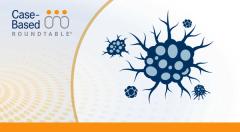
Nirogacestat Shows Improved PFS and Quick Response in Desmoid Tumors
Mark Agulnik, MD, discusses the efficacy and adverse events in the DeFi trial for patients with desmoid tumors given nirogacestat.
Episodes in this series

Mark Agulnik, MD, professor of Clinical Medicine, Vice Chair for Faculty Development, Department of Medicine, and Section Chief of Sarcomas & Melanoma at the Keck School of Medicine of USC, discusses the outcomes for patients with desmoid tumors given nirogacestat (Ogsiveo) in the DeFi trial (NCT03785964).
Nirogacestat showed a significant improvement in progression-free survival (PFS) compared with placebo, with a 76% PFS rate at 2 years, vs 44% with placebo. Agulnik noted there was also a faster response with nirogacestat, with median time to response of 5.6 months vs 11.1 months. The objective response rate (ORR) was 41%, including 7% with a complete response (CR), compared with 8% ORR with placebo (P < .001) and an 11.1-month median time to response.
However, nirogacestat treatment is associated with different adverse events (AEs) than placebo, including diarrhea, nausea, low phosphorus, rash, and ovarian dysfunction in women of childbearing potential. These AEs would be important to discuss with patients when considering using the drug as treatment, according to Agulnik. Although more frequent, 95% of the AEs reported with nirogacestat were grade 1 or 2.
TRANSCRIPTION:
0:10 | I think if we look at how patients [receiving] placebo do vs nirogacestat, we see that nirogacestat does have a significant improvement in PFS and the amount of patients who were progression free at 2 years was almost 3 out of every 4 patients, or 76%. That was substantially greater than the patients who were on placebo, and that was less than 50% of patients [who] had lack of disease growth within the first 2 years. When we also look at how quickly patients respond to treatment, for those who have a response—which is 41% of patients who are receiving nirogacestat, with about 7% of them having a CR—these patients are responding within 6 months, where the average patient has a response at about 5 and a half months. So that's very important also.
0:59 | From a symptom standpoint, or an introduction of AEs standpoint, it is true that patients who are on active treatments do have different AEs than those who are on placebo. Placebo is traditionally the AEs of the disease, whereas when they're on the nirogacestat, the majority of patients did have some form of [AEs], including diarrhea, nausea, low phosphorus, rash, and particularly [in] women of childbearing potential, about 3 out of every 4 of them had some AE that was consistent with ovarian dysfunction. That would be very important to note when we're discussing these therapies with our patients.







































